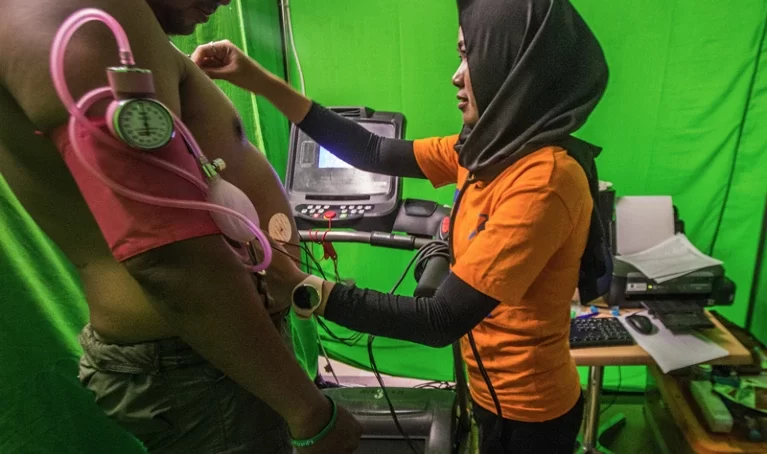
As an obesity physician, Fatima Cody Stanford has treated many people whose weight was causing them health problems. She has plenty of success stories: one woman, for instance, returned “stunning” cholesterol, blood-pressure and blood-sugar readings after working with Stanford for about 10 years.
But the woman still wanted more treatment. She was fixated on her body mass index or BMI, which classified her as having obesity. “She wants to lose more weight”, says Stanford, who is at Massachusetts General Hospital and Harvard Medical School in Boston.
BMI, which is calculated by dividing weight by height squared, has been used for several decades as an international standard to determine healthy weights. It serves as a proxy for body fat, and higher numbers can indicate increased risk for metabolic disease and death.
But BMI does not measure body fat, and it also ignores factors that affect how healthy someone is at a given weight, including age, sex and race. Not everyone with a high BMI has poor health or a raised risk of death1-3.
That’s why there is a small but growing movement to go beyond BMI when diagnosing and treating obesity, which the World Health Organization (WHO) recognises as a chronic disease. In June, the American Medical Association (AMA) called for more weight-related metrics to be used in conjunction with BMI owing to its imperfections and questionable history.
But, with global rates of obesity having tripled over the past 50 years and a wave of cutting-edge weight-loss drugs now hitting the market, a high BMI still reigns as the main criterion for obesity treatment. Specialists worry that the surging demand for the drugs will exacerbate reliance on BMI as a solo diagnostic tool.
“When we look at just height and weight, we don’t know anything about the health status of the individual,” Stanford says.
The origins of BMI had little to do with health. About 200 years ago, the Belgian astronomer and mathematician Adolphe Quetelet obsessed over characterising the ‘average man’. He recorded measurements of the human body – primarily in Western European men – and he found that weight roughly correlated with height squared.
Dividing the two numbers to describe weight relative to height became known as Quetelet’s index. His work on what was considered ‘normal’ had a role in the origins of eugenics.
In 1972, American physiologist Ancel Keys examined several height-weight indices and found that Quetelet’s was the best predictor of the thickness of body fat. He renamed it the body-mass index and proposed that it was a better indicator of healthy body size than were the height-weight tables commonly used at the time. These tables, based on actuarial data, showed weights associated with lowest risk of death and helped to set socially ‘ideal’ body sizes for much of the twentieth century.
BMI does correlate with the risk of death at the population level: the risk is elevated at the low end of the BMI spectrum, at which a person is considered underweight, decreases in the middle and gradually upturns again at the higher end, at which the overweight and then obesity categories lie (the cut-offs between these categories were set by the WHO in 1993).
But when looking at an individual, the clean cut-offs crumble. “BMI is a somewhat crude metric for determining health risks,” says Susan Yanovski, co-director of the Office of Obesity Research at the US National Institute of Diabetes and Digestive and Kidney Diseases in Bethesda, Maryland.
A study published in July found that the risk of death for adults in the overweight category was similar to that of people at ‘healthy’ weights, echoing earlier analyses. Another study found that about 30 per cent of participants with obesity had good cardiometabolic health, defined by factors including blood pressure and cholesterol levels. Around the same percentage of people with a healthy BMI was deemed cardiometabolically unhealthy.
The simplicity of BMI is probably what has kept it so prominent. “BMI doesn’t cost anything – it’s cheap and quick,” says Sarah Nutter, a psychologist and weight-stigma researcher at the University of Victoria in Canada. But the obsession with BMI, she says, “keeps us from being able to recognise that weight is not a good proxy for health”.
There’s no doubt that significant amounts of fat can harm organs, raise the risk of cardiometabolic conditions and wreak havoc on mental, physical and functional health.
The problem comes with using BMI as a proxy for the amount of body fat. Two adults with similar BMIs could carry different amounts of fat. At a given BMI, older adults tend to have more fat and less muscle than younger adults do. Relationships between BMI, fat mass and health also differ between sexes: women, for instance, tend to have more body fat than do men at the same BMI. Even so, “the distribution seems to be actually way healthier in women”, says Francisco Lopez-Jimenez, a cardiologist and obesity researcher at Mayo Clinic in Rochester, Minnesota. Their fat tends to lie in the buttocks, hips and thighs, whereas men usually accumulate belly fat, which is linked to poorer health outcomes.
Adult BMI charts don’t reflect this variability. And the cut-offs between BMI categories – which are the same in most countries that use the index to diagnose obesity – are “something between science-based and arbitrary”, says Lopez-Jimenez.
Regardless of a person’s sex, excess fat is most dangerous when it surrounds organs. This deeper, visceral fat is more metabolically active than is fat that sits under the skin, and a surplus is associated with insulin resistance, heart disease and other metabolic issues. It can cause problems even at a healthy BMI, Lopez-Jimenez says. “The reliance on BMI is making us not see the reality of normal-weight obesity.”
And because BMI was developed using measurements from white people, people of colour “don’t quite fit into these narrow parameters”, Stanford says. Data suggest that body composition and location of fat vary between racial and ethnic populations.
For instance, Asian people tend to be at a greater risk of conditions such as heart disease at lower BMIs than are white people, probably owing to differences in body-fat percentage and distribution. The WHO recommends that Asian populations use lower BMI cut-offs for overweight and obesity, which several Asia-Pacific countries now do.
These omissions are why the AMA adopted a policy in June to downplay the clinical use of BMI, calling it “an imperfect measure” that has been used for “racist exclusion” and that has caused “historical harm”. The policy suggests combining other metrics, such as waist circumference or body composition, with BMI.
Specialists who spoke to Nature advise using BMI as a screening aid, rather than a diagnostic tool, to flag who might benefit from further tests. “It gives me a sense of how much weight you’re carrying,” Stanford says. “But then I need to determine what the health is at that particular weight.” Clinicians could take account of cholesterol, blood sugar and even family history and genetics, which play a large part in obesity and related conditions.
But Stanford and others who have long scrutinised BMI worry that health professionals don’t have time for extra diagnostic steps. In primary-care visits, “they have 15 minutes to cover everything about the person”, she says. For instance, the US Centres for Disease Control and Prevention generally recommends that healthy adults receive cholesterol tests only once every few years.
That’s especially concerning with the exploding demand for new anti-obesity medications. In the United States, a person can be prescribed semaglutide for weight loss simply if their BMI is 30 (the lower bound of the obesity category) or more. With a BMI of between 25 and 30 – the overweight category – a person needs just one weight-related condition, such as high blood pressure, to get a prescription.
“If you have 15 minutes in a visit,” Stanford says, “you’re going to follow the BMI … instead of really taking the time to see ‘Do they need the medication?’”
In Lopez-Jimenez’s experience, the problem is compounded by patients requesting the medications – often for aesthetic, rather than medical, reasons. Several efforts to define obesity beyond BMI have popped up over the years.
Stanford is part of a commission of about 60 obesity specialists from around the world, brought together by the journal Lancet Diabetes & Endocrinology and the Institute of Diabetes, Endocrinology and Obesity at Kings Health Partners in London. The group is coming up with diagnostic criteria by examining every major organ system to understand how weight affects health, Stanford says. She estimates that the full report should come out next year.
Today’s most widespread framework came from an overwhelmed obesity clinic. Around 2,000 people were on the waiting list for the service at the Royal Alexandra Hospital in Edmonton, Canada, in the mid-2000s, says Arya Sharma, then the clinic’s medical director. The average wait was almost 18 months and the clinic worked on a first come, first served basis.
Sharma thought that BMI probably wasn’t a good indicator of who to prioritise for urgent care. “It tells me how big you are,” says Sharma, who is now based in Berlin. “It doesn’t tell me how sick you are.”
He co-created a five-step system, published in 2009, that accounts for physical, mental and functional health in addition to BMI, called the Edmonton Obesity Staging System (EOSS). A person who has several weight-related conditions, such as difficulty moving, heart disease and anxiety related to obesity, would be at a higher stage than someone with the same BMI but with fewer or less-severe health problems.
EOSS was folded into the 2020 Canadian clinical guideline for obesity in adults, and late last year, versions were launched in Chile and Ireland. It’s Chile’s first comprehensive guideline for obesity care, says Yudith Preiss Contreras, a clinical nutrition specialist at MEDS Clinic in Santiago, who was its lead developer. “Everybody’s using our guideline.”
Still, the greater push to go beyond BMI has just begun. “You’re starting to see this seep into guidelines,” Stanford says. But “that translation into clinical practice will be a larger hurdle to overcome.”
- A Nature report











